Leadership by Design
Executive spaces are not designed for hybrid work. It’s time for change.
It used to be an experiment on the fringes, but hybrid work has gone mainstream and it’s one of the biggest economic and cultural changes facing leaders today. Most organizations who choose hybrid work are trying to offer a balance between the flexibility people want and the need to bring employees together to create greater cohesion and build a sense of community. Some leaders worry their corporate culture is slowly dissolving and talk of “quiet quitting” – pulling back from work while staying in the job (or, as some would say, a Tik Tok term for disengagement) – is making them think it’s time to make sure they’re leading by example.
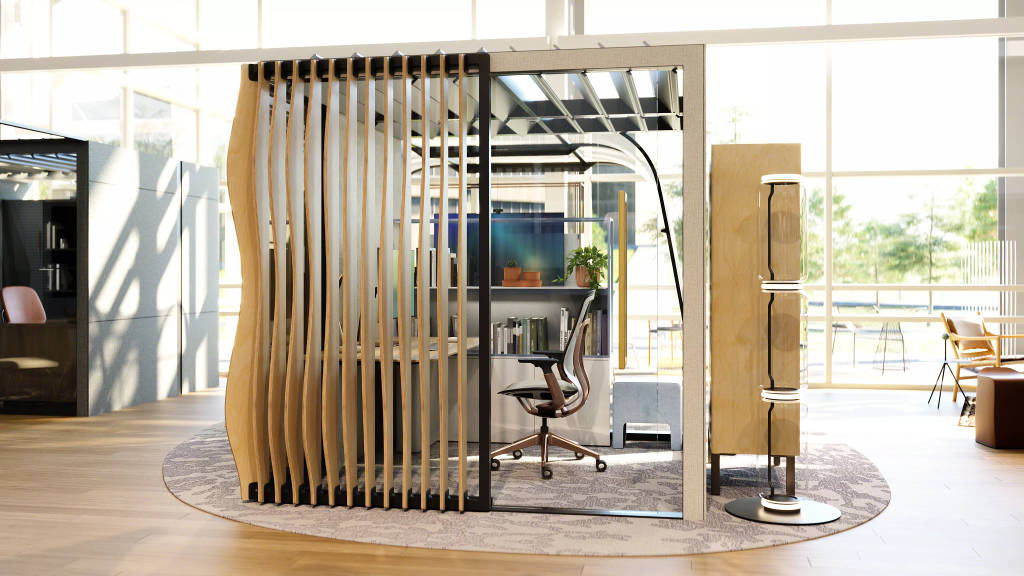
*Some products in the photos are not available in EMEA
Hybrid work policies can be a struggle for companies when people come into offices that still look like ghost towns. There’s a critical mass that’s needed to gain momentum and leaders play a critical role – they need to be accessible in ways they may not have considered in the past and to set the tone for the adoption of hybrid work. “‘Congratulations. You are the new amenity,’” McKinsey’s Workplace Strategy and Change Leader Phil Kirschner tells leaders. “It used to be the gym, the cafeteria, being able to bring puppies to work, whatever it is, but the executives are the new amenity.”
“‘Congratulations. You are the new amenity. It used to be the gym, the cafeteria, being able to bring puppies to work, whatever it is, but the executives are the new amenity.”
Phil KirschnerMcKinsey Workplace Strategy and Change Leader
But the current office might be a barrier to leaders who want to be accessible and role models for hybrid. Workplace design traditionally focused on leaders’ needs by creating executive floors or suites that were set apart from the rest of the organization. It became a constraint to building transparency and made it harder for leaders to have serendipitous connections with employees. A fundamentally different approach to leadership spaces can be an important tool for building the kind of culture and fostering the kind of behaviors leaders want to see.
Accessible. Approachable. Functional.
One of the things we know from our research is that employees want their leaders to be visible, accessible and transparent in how they run the business. For many leaders this requires new behaviors and practices, which can be a challenge because they also need to get their jobs done.
So how can leaders balance the need to be more approachable to employees yet still have space to handle the moments of crisis they’re dealing with more frequently, as well as the day-to-day needs of the organization? How can they collaborate as a leadership team and share quickly with each other as well as the larger organization. And how do they do all this in a hybrid work environment when they need to interact with people in-room and remote participants?
“Our clients are telling us they are struggling with these issues and looking to us to help them,” says Steelcase CEO Sara Armbruster. “This is a time of seismic change and we believe space can help shape new leadership behaviors. We have a history of prototyping and testing progressive new ways for leaders to work. Our new leadership space applies our research and insights to create an innovative approach for leaders in a hybrid world.”
The new space, called the “Leader Commons” and located within the Steelcase Learning and Innovation Center in Grand Rapids, Michigan is a behavioral prototype – a fully-built-out environment where concepts are tested and evaluated in real time. Like its name implies, this space is designed to be highly accessible and approachable for employees, yet functional for the demands of leadership roles. It offers spaces where they can focus and collaborate, both in- person and remotely.
“We know organizations need to rebuild the social capital that was lost while everyone worked from home, “says Cherie Johnson, global design director. “Traditional leadership spaces don’t offer the transparency and accessibility people want today.”
The design was inspired by dynamic neighborhoods that have a range of diverse public and private spaces which encourages equity, engagement and ease of use to address the needs of hybrid work.
Designing a Leadership Neighborhood
The design concept of creating spaces that are more like a vibrant neighborhood is based on our belief that the workplace needs to be more inclusive and create the sense of community that people and organizations need to thrive. Neighborhoods are a tangible way for organizations to communicate their values and shift their culture.
Every neighborhood has its own distinctive character and four key design principles guide their creation.
- Me + We: Just as city neighborhoods have homes and shared spaces, a leadership community should support both individual and team work.
- Fixed-to-Fluid: Leaders need a highly adaptable and resilient space that can ebb and flow with their needs. The easier it is for them to make changes on demand, the more effective the space will be.
- Open + Enclosed: Privacy and the ability to focus in the office has become even more important. Leaders need to be able to find the level of privacy they require
- Braiding Digital + Physical: Every space may need to be a video space. Video meetings are a new norm in the office and everyone needs to see and be seen, hear and be heard. Technology and the physical space need to be considered holistically to provide an equitable experience for both in-person and remote participants.
Topography of a Leadership Neighborhood
A leadership neighborhood includes a diverse range of owned and shared spaces that meet the various needs of hybrid work.

1. C-Suite Home Bases
Owned individual spaces that provide for focus and 1:1 collaboration, with “front porches” to encourage visibility and interaction with other leaders and employees. Custom-curated background for video calls and embedded technology, enhance the experience of video meetings.
2. Executive Assistants Pods
Workspaces provide proximity to leaders as well as to other assistants who work as a team to support leaders. Highly mobile furnishings allow for personal control and preferences.
3. Social Hub
Located at the entrance of a Leader Commons, this approachable space encourages people to gather and allows informal access to leaders. It can be an “on deck” area for people coming to attend scheduled meetings.
4. Courtyard
Located in the center of resident spaces, it’s a space where leaders can easily come together, with mobile boundary elements that can accommodate varying team sizes, provide visual and acoustic privacy and enable hybrid collaboration.
5. Front Porch
Located near main traffic thoroughfares, these informal and comfortable ancillary office spaces can be used before and after meetings, as touchdown spaces, for casual conversations or for hosting guests.
6. Community Meeting Spaces
A range of fully enclosed, bookable meeting spaces are equipped to support hybrid collaboration and are available to all employees. These include Hybrid Huddle Rooms, Hybrid Active Collaboration Spaces and Hybrid Informative Collaboration Rooms. (see sidebar).
7. Communication Kiosks
Analog and digital media integrated throughout the space provide places for storytelling and messaging to both employees and guests (not shown in floor plan).
A New Vision for Leadership Spaces to Support Hybrid Work

C-Suite Home Base
This new kind of CEO space is highly visible, positioned on a main traffic path, yet gives leaders the privacy they need to do their work. Designed around a freestanding pod, the space has multiple areas for different kinds of work. Close the sliding door for deep focus work or video calls (each leader has a curated background that speaks to who they are).
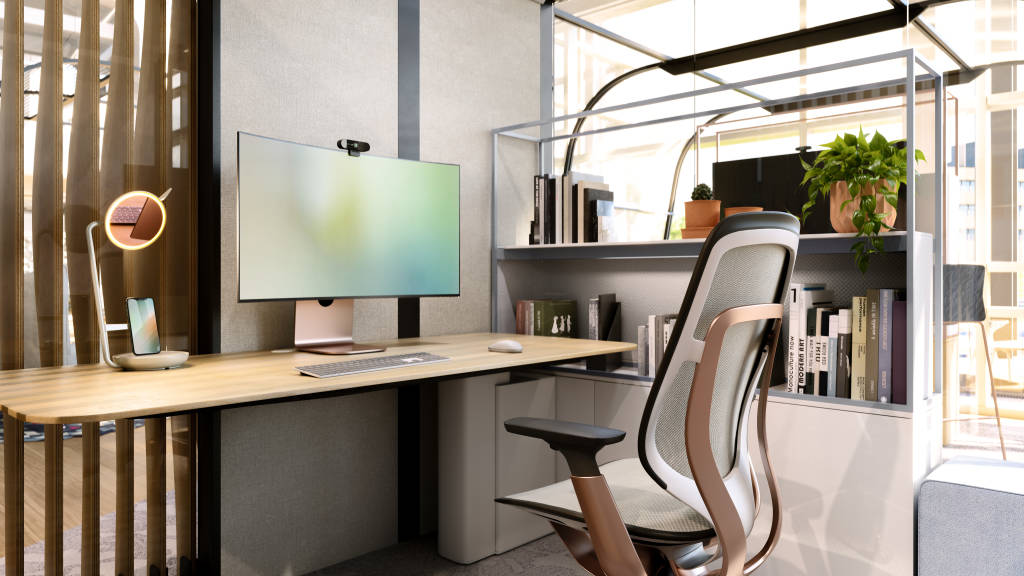
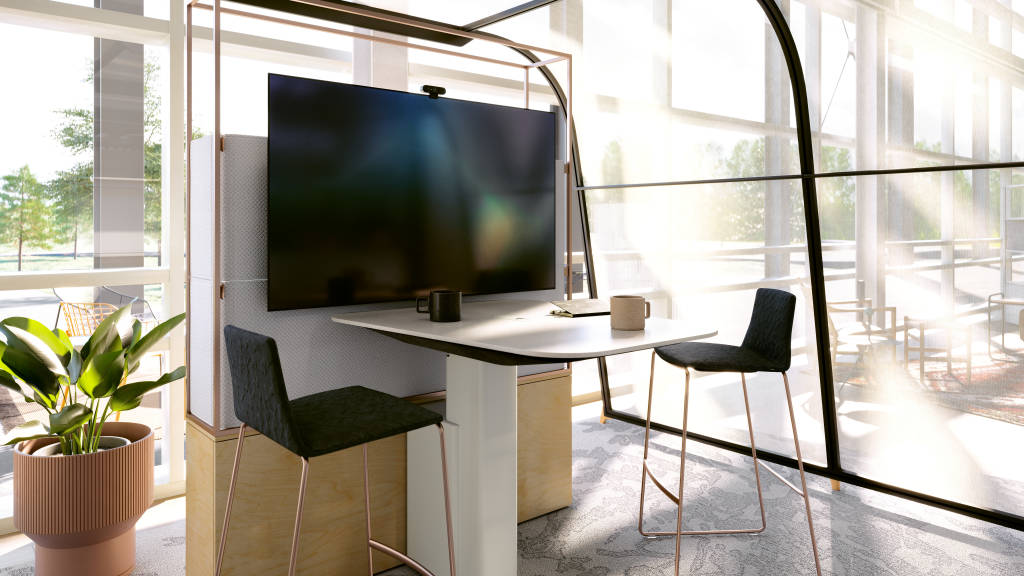
C-Suite Home Base: An Alternative Approach
For leaders who prefer a more open environment, boundary elements provide shielded privacy and the opportunity to personalize the space.
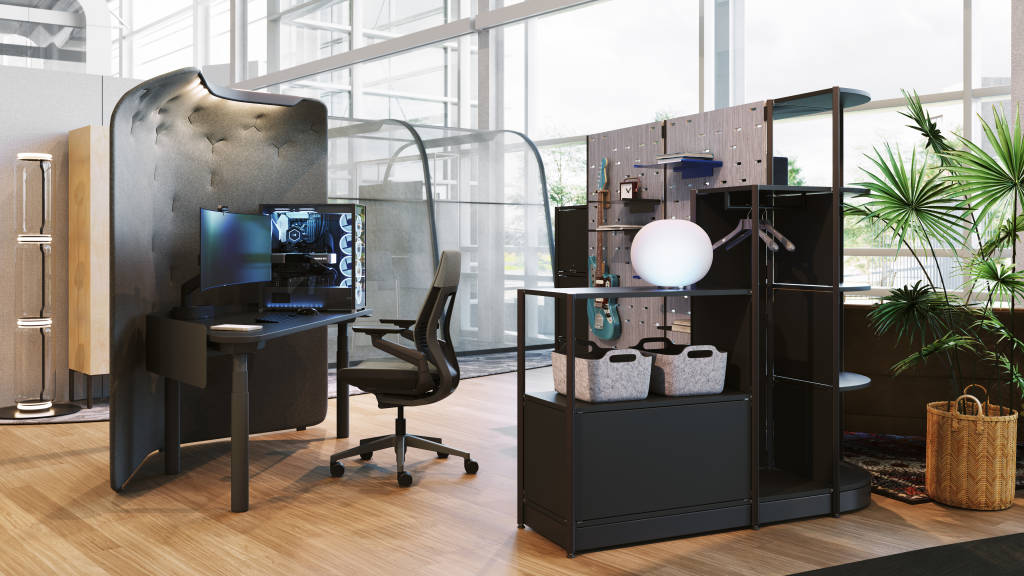

Social Hub
An approachable and multipurpose café space for leaders and employees to meet; ideal for connecting before and after meetings with leadership. It also includes touchdown spaces for people to do individual work.
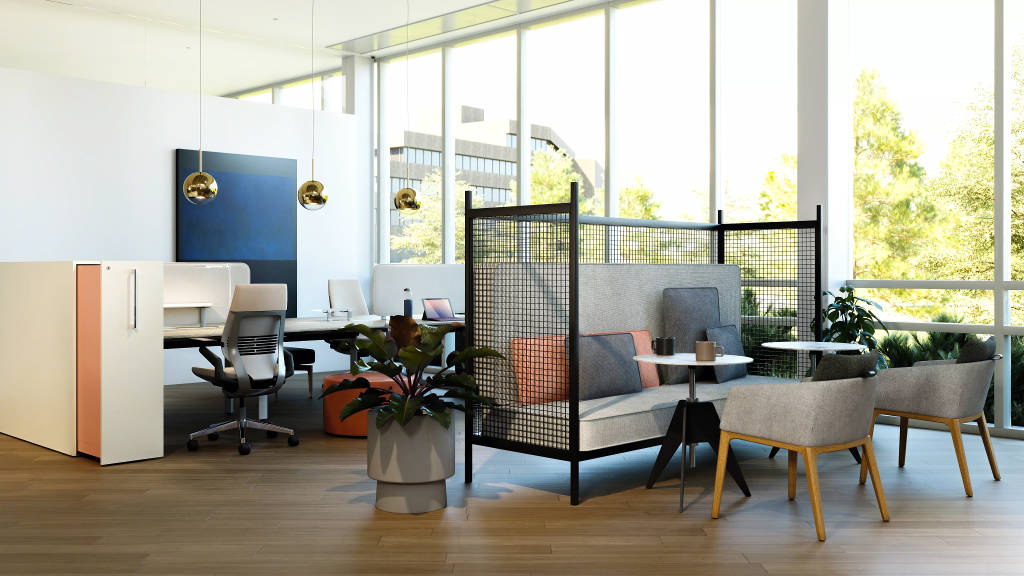
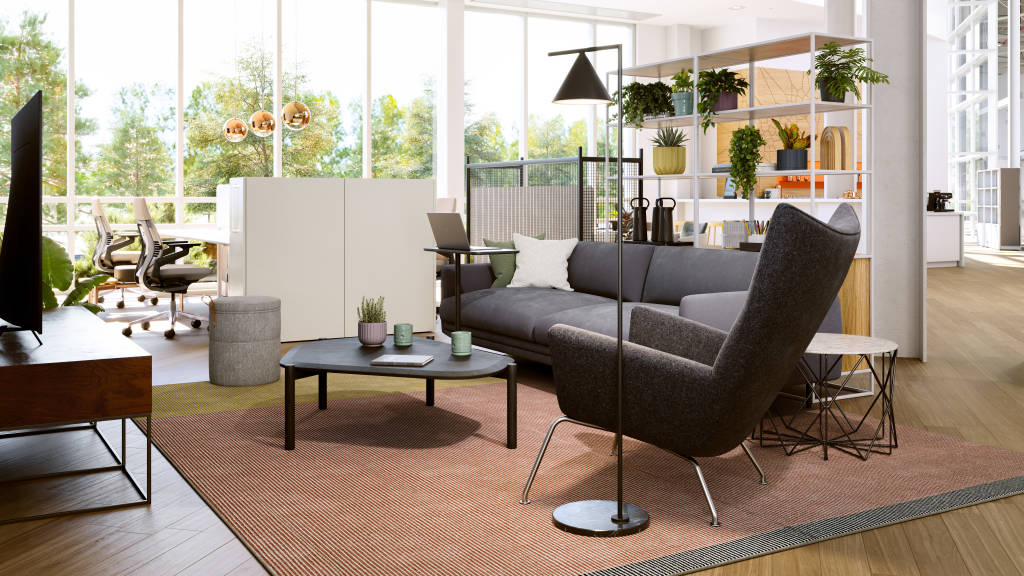
Remote Leader Space
This novel approach gives remote leaders a place to call home when they are in the office. A “work tent” for individual work, a front porch for informal meetings, and a freestanding acoustic pod provide a range of spaces from which to choose.
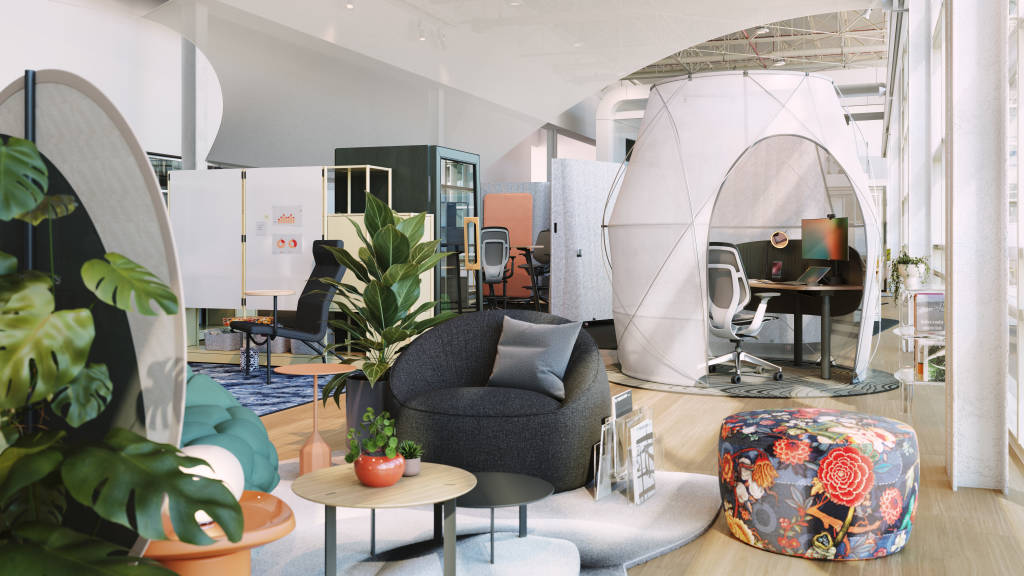
Leading by Example
Bringing people back together recharged and reinvigorated is perhaps the greatest challenge leaders have today, regardless of what their hybrid work strategy may be. There’s never been a greater time for leaders to lead by example and demonstrate the culture and behavior they expect from their employees, which will require a new approach to leadership spaces.
Behind the Scenes
The Steelcase design team and the Applied Research & Consulting (ARC) group worked closely with Steelcase leaders to better understand the new behaviors they wanted the space to support and what changes needed to be made to help re-energize the organization’s culture. The ARC team conducted a series of discovery exercises, workshops, surveys and interviews to better understand the challenges leaders faced and how the space should be designed to support the new needs of hybrid work.
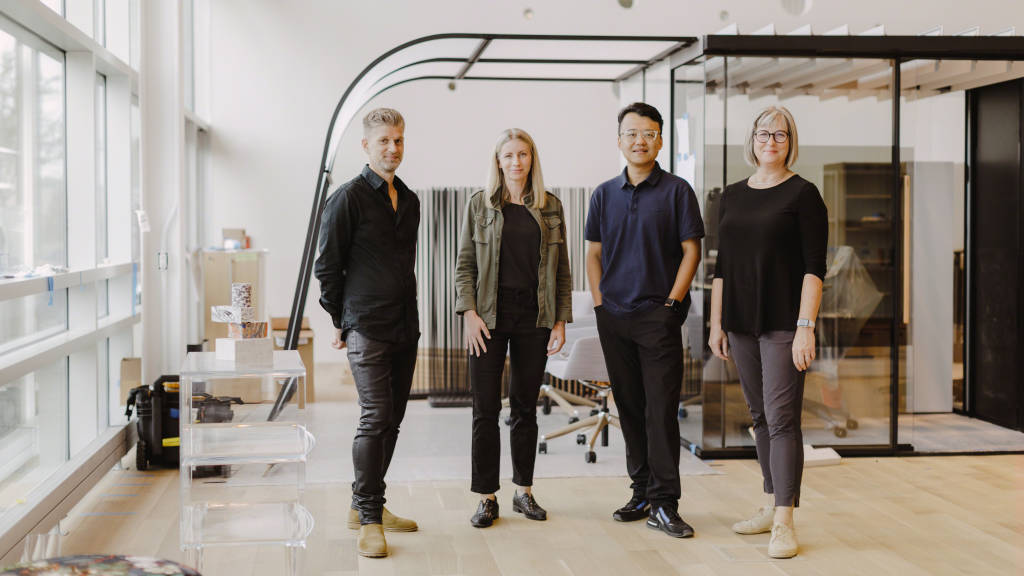
The Steelcase design team used a highly collaborative process with leaders to create the Leader Commons. Through the use of survey tools and one-on-one interviews, they learned about each person’s leadership style and how they prefer to work — alone and together with others. The result was a range of solutions that solved the tension between the needs for accessibility and privacy.
“Every individual workspace was designed to enhance performance as well as provide sanctuary,” says Cherie Johnson, global design director. “But they are unique in how they achieve that. Every workspace provides similar amenities and tools, but differs in how we tailor visual privacy, and how they are represented as individuals. Curating a space that embodies their personality and creates a personal connection when seen on video calls or in person was an important part of this new hybrid experience.”
Making Hybrid Work
Hybrid work will require new kinds of spaces for leaders to connect easily with both in-person and remote participants and the right technology is essential for a seamless experience. Leaders need a variety of hybrid collaboration options for both 1:1 and group conversations in open and enclosed spaces that are easily accessible.
Steelcase is collaborating with industry-leading technology companies Microsoft, Zoom, Logitech, Crestron and VergeSense to rethink the hybrid work experience and create holistic solutions that integrate space and technology to make sure people can see and be seen, hear and be heard and participate equally. We work together early in the design process to create spaces that work better for people, teams and organizations.


